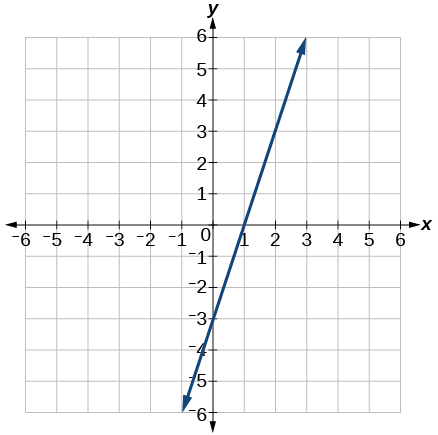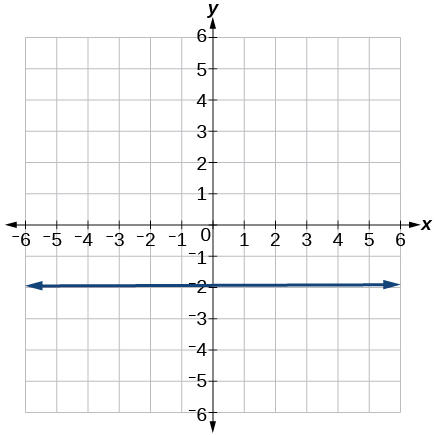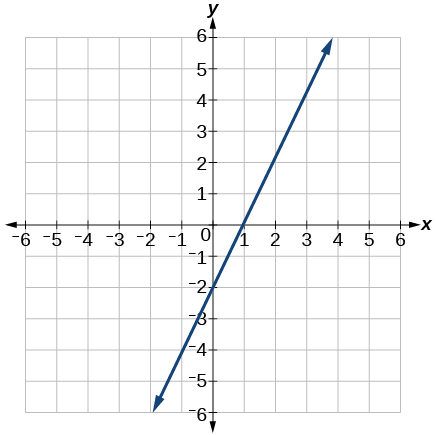4.1E: Funciones Lineales (Ejercicios)
- Page ID
- 111859
1. Determinar si la ecuación algebraica es lineal. \(2 x+3 y=7\)
2. Determinar si la ecuación algebraica es lineal. \(6 x^{2}-y=5\)
3. Determinar si la función está aumentando o disminuyendo. \[f(x)=7 x-2 \nonumber\]
4. Determinar si la función está aumentando o disminuyendo. \[g(x)=-x+2 \nonumber\]
5. Dado cada conjunto de información, encontrar una ecuación lineal que satisfaga las condiciones dadas, si es posible.
Pasa a través de (7,5) y (3,17)
6. Dado cada conjunto de información, encontrar una ecuación lineal que satisfaga las condiciones dadas, si es posible.
\(x\)-interceptar en (6,0) y\(y\) -interceptar en (0,10)
7. Encuentra la pendiente de la línea que se muestra en la gráfica.

8

9.

10
¿La siguiente tabla representa una función lineal? Si es así, encuentra la ecuación lineal que modela los datos.
| x | —4 | 0 | 2 | 10 |
|---|---|---|---|---|
| g (x) | 18 | —2 | —12 | —52 |
¿La siguiente tabla representa una función lineal? Si es así, encuentra la ecuación lineal que modela los datos.
| x | 6 | 8 | 12 | 26 |
|---|---|---|---|---|
| g (x) | —8 | —12 | —18 | —46 |
12. En junio\(1^{\text {st }}\), una empresa tiene\(\$ 4,000,000\) ganancias. Si entonces la empresa pierde 150.000 dólares diarios a partir de entonces en el mes de junio, ¿cuál es la ganancia\(n^{\text {th }}\) de la compañía después de junio\(1^{\text {st }}\)?
Para los siguientes ejercicios, determine si las líneas dadas por las ecuaciones siguientes son paralelas, perpendiculares, o no paralelas ni perpendiculares:
13. \[\begin{align*} 2 x-6 y &=12 \\[4pt] -x+3 y &=1 \end{align*}\]
14\[\begin{align*} y &=\frac{1}{3} x-2 \\[4pt] 3 x+y &=-9 \end{align*}\]
Para los siguientes ejercicios, encuentre las intercepciones\(x\)\(y\) - y - de la ecuación dada
15. \(7 x+9 y=-63\)
16. \(f(x)=2 x-1\)
Para los siguientes ejercicios, utilice las descripciones de los pares de líneas para encontrar las pendientes de la Línea 1 y la Línea\(2 .\) ¿Cada par de líneas es paralela, perpendicular o ninguna?
17.
- Línea 1: Pasa a través (5,11) y (10,1)
- Línea 2: Pasa a través de (-1,3) y (-5,11)
18.
- Línea 1: Pasa a través de (8, -10) y (0, -26)
- Línea 2: Pasa a través de (2,5) y (4,4)
19. Escribe una ecuación para una línea perpendicular al punto\(f(x)=5 x-1\) y que pasa por él (5,20).
20. Encuentra la ecuación de una línea con una\(y\) - intercepción de (0,2) y pendiente\(-\frac{1}{2}\).
23. Una empresa de alquiler de autos ofrece dos planes para rentar un auto.
- Plan A: 25 dólares por día y 10 centavos por milla
- Plan B: 50 dólares por día con kilometraje ilimitado gratuito
¿Cuántas millas necesitarías conducir para el plan B para ahorrarte dinero?


